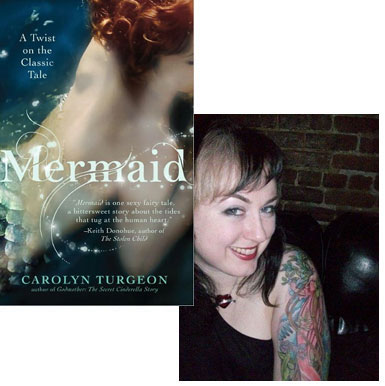Carolyn Turgeon Likes to Play with Fairytales

Every two years or so, Carolyn Turgeon comes up with a guest essay for Beatrice: In late 2006, she wrote about Giovanni Verga; in early 2009, she explained her take on Cinderella’s fairy godmother. When Carolyn told me that her new book, Mermaid, was a love-triangle spin on “The Little Mermaid,” I asked what it was about her and fairy tales—and this is what she told me. If you’re in the New York City area, you can see her read at the Tribeca Barnes & Noble on Thursday, March 3—but readers everywhere can follow her latest fascination at I Am a Mermaid, a blog where she asks celebrities like Tim Gunn, Jane Yolen, Dame Darcy, and Michael Wm. Kaluta for their perspective on the subject.
So my third novel, Mermaid, is a retelling of the original little mermaid story by Hans Christian Andersen; my previous novel, Godmother, came out two years ago this week and was told from the perspective of Cinderella’s fairy godmother, now an old lady with wings living in New York City’s Garment District. My first middle-grade novel, The Next Full Moon, comes out on June 7, and is about a 12-year-old girl who begins to grow feathers and discovers that her mother was/is actually a swan maiden; it’s based on the old fairytale of a man who steals a swan maiden’s feathered robe (there are many similar tails about a man stealing a selkie’s seal skin), leaving her stuck in her human form. He marries her and has a child with her and then one day confesses to her what he’s done, showing her the robe. Immediately she puts it on and flies away. My story’s about the kid she left behind.
I guess you could say that I like fairytales. A lot.
From my perspective, I’m not sure what there isn’t to like, really. These are stories about basic longings, about clashing worlds, about being in one world and longing to be in another one. They’re about magic and beauty and souls and love, and about being in dark, lonely, terrifying places far away from those things. A swan maiden falling to earth, a mermaid longing to be human, an orphaned girl covered in dirt, hoping to fall in love with a prince. They’re stories that have been told and retold and retold, and you know them, you’ve always known them, they’re in your blood. I know that Cinderella and Snow White are as much a part of my childhood as the fireflies that lit up our Illinois backyard every summer evening, the weeping willows that stretched over the creek down the street. That’s as much Disney as anything else, but Disney just retold stories that had been retold plenty of times before.
I think there’s something meaningful, even profound, in taking something that we all know, a story in our blood and bones, a fairytale or a classic, and flipping it around some to explore it from a new angle. I think there’s something profound about Jean Rhys’ Wide Sargasso Sea, looking at the madwoman in the attic from Jane Eyre and telling her story. I remember the astonishment I felt, that sense of excitement, realizing that she, too, had a story, that mad woman, that there was another way to look at her aside from through Jane. It surprises me how easy it is to forget something so obvious: that there are always stories within stories, that there are always other points of views besides the one that told us the story in the first place.
To me, it’s a reminder that there is always another way to see things. That just because we’re stuck in one body and one self doesn’t mean we can’t imagine our way out of them, and into new worlds. To me, it’s a way of getting to the human world the way the mermaid longs to, or getting to the ball in the carriages made from pumpkins, or getting into that attic where the mad lady lives.
2 March 2011 | guest authors |

 Our Endless and Proper Work is my new book with Belt Publishing about starting (and sticking to) a productive writing practice.
Our Endless and Proper Work is my new book with Belt Publishing about starting (and sticking to) a productive writing practice. 
